SCH4U1
Unit 2 à Structure and Properties
STSE Focus:
C1.1 assess the benefits to society of technologies that are based on the principles of atomic and molecular structures (e.g., magnetic resonance imaging [MRI], infrared spectroscopy, X-ray crystallography, nuclear energy, medical applications of spectroscopy and mass spectrometry)
Sample issue: In medicine, radioisotopes are bonded with chemical compounds to form radioactive tracers, which are then injected into the patient’s bloodstream. The radiation emitted by the tracers allows doctors to obtain images of organ systems, facilitating the early and accurate diagnosis of disease. However, to avoid radioactive contamination, care must be taken in the storage, use, and disposal of this material.
Sample questions:How does infrared spectroscopy aid in criminal investigations? How has the use of X-ray crystallography and mass spectrometry advanced our understanding of atomic and molecular structure? What social benefits are associated with such advances?
C1.2 evaluate the benefits to society, and the impact on the environment, of specialized materials that have been created on the basis of scientific research into the structure of matter and chemical bonding (e.g., bulletproof fabric, nanotechnologies, superconductors, instant adhesives)
Sample issue:Nanoparticles have many potential applications in medicine, including the improvement of drug delivery systems, the enhancement of diagnostic images, and use in surgical robotics, all of which could improve the effectiveness of our health care system. However, nanoparticle contamination can have a negative effect on the environment.
Sample questions:What precautions are taken to protect the health and safety of people working with nanoparticles? What properties of disposable diapers enable them to hold so much liquid? What impact has the widespread use of such diapers had on the environment? What impact has the development of synthetic fibres, such as nylon, had on society? What would your life be like if there were no plastics? In what ways has the invention of the silicon chip changed society?
SCH4U1
UNIT 2 – Atomic Theory (Chapter 3)
Introduction:
à Specialized materials: “Super-glue” (cyanoacrylate) ; Kevlar ; bulletproof fabric ; Teflon ; semiconductors ; nanotubes
à Medical Technologies: Magnetic Resonance Imaging (MRI); X-rays, Lasers
à Northern Lights (aurora borealis):
- streams of protons and electrons (plasma) emanating from sun
- electrons from plasma interact with gaseous atoms in earth’s upper atmosphere
- atoms emit coloured light. Why? Why do they emit a limited range of specific wavelengths and not the full visible wavelength?
- How do these interactions (electron with gaseous atoms) lead to atoms of different elements emitting light with characteristic wavelengths?
à Unit Objectives:
Understand:
- the developments that lead to the modern model of the atoms;
- the Quantum Mechanical model of the atom;
*Review: What is an atom?
à
à The word “atom” is derived from the Greek word _____________ which means _____________.
Atomism – A Very Brief History
*The Greek Philosophers Leucippus & Democritus (~ 400 B.C.)
à Atoms are not an invention of the 20th century. The Greek philosopher, Leucippus, first proposed their existence over 2000 years ago. Another Greek philosopher, Democritus, expanded on Leucippus’ ideas several decades later.
*Aristotle
à The atomism of Democritus was eclipsed for nearly 2000 years by the theories of the great intellectual authority of the time, Aristotle. He proposed that all matter was composed of four “elements” – _____, ___________, _______ and ________.
*John DALTON (1807 - “________________”)
à English schoolteacher ; was colour-blind
à first to obtain _______________________ evidence that supported atomic composition theory
à laid the foundations of modern atomic theory
*ATOM = _________________________________________
The Atomic Theory of Matter (Dalton vs. Modern View)
Dalton |
The Modern View |
i) All matter is composed of tiny indivisible, |
|
ii) Atoms of one element cannot be converted into |
|
iii) Atoms of one element have the same, unique |
|
iv) Atoms of different elements combine in |
|
*Sir J. J. THOMSON (1904 - “________________________”)
 à Thomson won the Nobel Prize and was later knighted (a British thing…hence, the “Sir” in front of his name) for his scientific achievements. SEVEN scientists that worked under Thomson later won the Nobel prize!
à Thomson won the Nobel Prize and was later knighted (a British thing…hence, the “Sir” in front of his name) for his scientific achievements. SEVEN scientists that worked under Thomson later won the Nobel prize!
à obtained experimental evidence that electricity is not a “subtle fluid” but consists of particles called _________________
à demonstrated that electrons are universal components of all atoms
*ATOM = ________________________________________________________________________
*H. Becquerel and Marie and P. Curie (1896 – 1899 à discovered _______________)
 *What is radioactivity? à Some atoms such as ____________________ and _______________naturally emit __________ (ά) positive particles and ____________ (β) negative particles and _____________(γ) radiation energy . (alpha particle = ___________ nucleus ; beta particle = ___________)
*What is radioactivity? à Some atoms such as ____________________ and _______________naturally emit __________ (ά) positive particles and ____________ (β) negative particles and _____________(γ) radiation energy . (alpha particle = ___________ nucleus ; beta particle = ___________)
*Ernest RUTHERFORD (1911 – “_______________________”)
à worked at Canada’s McGill University for some of his career
à Rutherford was one of Thomson’s distinguished seven.
à the first to succeed in exploring the _______________ ______________ of atoms
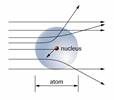 à Performed famous “________ ________ Experiment” à The experimental evidence that led to the Rutherford model was the results of bombarding a thin metal foil with an ________ particle (helium nuclei) beam. The beam was mostly____________, as expected; however, a small but significant number of alpha particles were deflected – some, through very large angles.
à Performed famous “________ ________ Experiment” à The experimental evidence that led to the Rutherford model was the results of bombarding a thin metal foil with an ________ particle (helium nuclei) beam. The beam was mostly____________, as expected; however, a small but significant number of alpha particles were deflected – some, through very large angles.
http://www.mhhe.com/physsci/chemistry/essentialchemistry/flash/ruther14.swf
*ATOM:
à
à
*PROBLEMS With Rutherford Model:
i) Nucleus –
ii) Could not explain total ___________ of the atom [discovery of the ____________ (Chadwick - 1932) helped explain 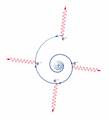 mass of atom)]
mass of atom)]
iii) Model proposed that electrons ________________ nucleus like planets orbit the sun.
**However, ________________ charges should continuously emit _____________ ____________ ( ) – this does not happen. Electron would eventually lose energy and ___________ into the nucleus.
iv) Could not explain atomic __________.
Neils Bohr…a Great Dane (1913 – “”)
à worked under Rutherford
à combined the experimental findings of ____________ with the theoretical concepts of _________ and ______________ to develop the Bohr model of the atom
à successfully described the _____________ of an electron and many experimental observations in chemistry and _______________
*Max Planck (1900)
à A German theoretical physicist named Max Planck suggested that matter at the atomic level can absorb or emit only discrete, specific quantities or “packets” of energy. Each of these specific quantities is called a _____________ of energy. The energy of an atom is __________________; it is not ___________________. What does this mean?
*Albert Einstein (1905)
à light is emitted and absorbed in quantized amounts
à A quantum of light energy is called a __________. (a very small “packet” of EMR)
Pre-Bohr Model Activity: The Electromagetic Spectrum and Atomic Spectra
1. a) What is the electromagnetic spectrum?
àThe full array of all types of ______________ ______________ is called the electromagnetic spectrum. It extends from the shortest wavelength _____________ rays to the longest wavelength __________waves. *Visible light forms only a _______ portion of the full electromagnetic spectrum. In a vacuum, all EMR travels at the speed of _________ (______________m/s)
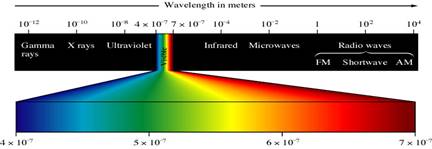
b) What distinguishes one type of EMR from another?
à ______________/______________
à Wavelength and frequency are _______________ related – as the frequency of the EMR increases, the wavelength ______________ and vice versa.
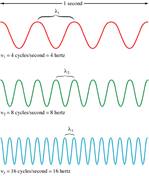
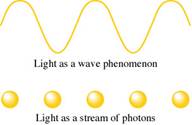
2. How is the energy of a photon calculated?
E = _____
Where:
E is the energy in _____________ (J)
h is ___________ ____________ (6.6 x 10-34)
f is the _________________ (of the EMR) in hertz (Hz)
Example:
Ultraviolet (UV) light that causes tanning and burning of the skin has a higher energy per photon than infrared (IR) light from a heat lamp.
*Calculate the energy of a 1.5 x 1015 Hz UV photon and a 3.3. x 1014 Hz IR photon.
à energy of UV photon: àenergy of IR photon:
E = hf E = hf
= =
= =
*Therefore, the energy of a photon is solely dependant on the _________________ of the EMR.
(i.e. higher frequency = more ______________)
(e.g. E of UV photon > E of blue light photon > E of red light photon > E of infrared photon etc.)
3. a) What is a spectroscope?
à invented by Robert Bunsen and Gustav Kirchoff
à Their spectroscope was a _________ that split light into its component frequencies. [e.g. A spectroscope splits white light into a __________________ (colours blend into one another) “rainbow” spectrum.
Remember: Each colour represents a different frequency/wavelength of EMR.
b) What is spectroscopy?
à a technique for analyzing atomic ________________ (e.g. Stellar spectroscopy is a technique used to identify the _______ present in the atmospheres of distant stars.)
4. What is an emission (____________-line) spectrum? How is it attained?
(**Activity à gas discharge tubes)
à When a gas is excited by __________ or ______________, for example, and then passed through a __________________, a series of bright lines (against a ___________ background) of light are produced. The resulting array of bright lines is called an ___________________spectrum.
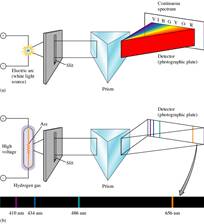 à A bright-line spectrum is not _____________________ (i.e. a complete rainbow of colours is not observed).
à A bright-line spectrum is not _____________________ (i.e. a complete rainbow of colours is not observed).
à See p. 175 of text also.
http://www.mhhe.com/physsci/chemistry/essentialchemistry/flash/linesp16.swf
5. What is an absorption spectrum (____________-line spectrum)? How is it attained?
à A cool gas in front of a continuous source of light produces an ________________ spectrum – a series of dark spectral lines (i.e. missing parts) among the colours of the rainbow.
à This is the type of spectrum observed in stellar (star) spectroscopy.
à See p. 176.
6. What is the relationship between the bright and dark-line spectrums of an element?
à The dark lines in an element’s absorption spectrum are in the _________ position as the bright lines in the emission spectrum of the same element.
7. How do the emission/absorption spectrums produced by different atoms compare?
à Each element produces its own ___________ emission/absorption spectrum. The emission/absorption spectrum of an element can be thought of as its “______________”. This is why stellar spectroscopy is so powerful.
à (e.g. Although we are unable to travel to distant stars/galaxies, we are able to analyze the light emitted by these objects – the light that hits our telescopes and spectroscopes, that is. The light emitted by our sun produces a spectrum consistent with the “fingerprint” of helium. (“helios” = Greek word for “sun”) *Interestingly, helium was “discovered” on the sun before it was discovered here on Earth.
Specific Example: The Emission Spectrum of Hydrogen
http://www.mhhe.com/physsci/chemistry/essentialchemistry/flash/linesp16.swf
*ground state = the _____________ energy state available to an electron (also – state of greatest stability)
*excited state = any level _____________that the ground state
*When an electron moves from the ground state to an excited state, it must ___________ energy. When it moves from an excited state to the ground state, it ___________energy. This release of energy is the basis for ___________ ___________.
Example:
*When an electron of a hydrogen atom has been excited (in an electrical gas discharge tube, for example) to the third energy level falls to the second energy level, it ________ light with a specific energy. This energy corresponds with a specific wavelength in the electromagnetic spectrum. Specifically, an electron that makes a transition form the 3rd energy level to the 2nd energy level emits exactly 3.03 x 10-19 joules of energy which corresponds with a photon of ________ light with a wavelength of _____ nm (___ x 10-7 m).
λ = ![]() *Where h is Planck’s constant (6.6 x 10-34) and c = the speed of light (3.0 x 108 m/s).
*Where h is Planck’s constant (6.6 x 10-34) and c = the speed of light (3.0 x 108 m/s).
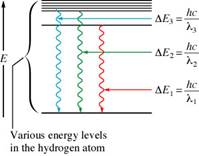
=
=
Hydrogen’s Emission Spectrum:
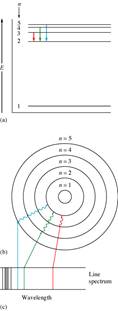 à The photon of green light = electron transition from level ____ to 2.
à The photon of green light = electron transition from level ____ to 2.
à The photon of blue light = electron transition from level ____ to 2
à The photon of violet light = electron transition from level ____ to 2.
**Notice that all of these transitions are from a _________ level down to level 2. Transitions down to energy level 2 are referred to as the ____________ series. Are other transitions possible?
*The ___________ series = transitions from higher levels down to level 1
à These transitions result in the emission of EMR in the _________________ portion of the spectrum. Therefore, the “lines” produced by these transitions ____________ be seen with the naked eye.
*The ______________ series = transitions from higher levels down to level 3
à These transitions result in the emission of EMR in the ____________ portion of the spectrum. Therefore, these “lines” cannot be seen with the naked eye either.
SUMMARY:
**What’s important to remember is that the emission spectrums produced by “excited” atoms extend into ranges of the EMR spectrum that we cannot ___________. As a result, the portion of the emission spectrum that we tend to focus on is the one we can see with the unaided eye.
Bohr’s Explanation of Atomic Spectra:
1. The atom has only ____________, allowable energy levels, called ________________states. Each stationary state corresponds to the atom’s electrons occupying fixed, ___________ orbits around the nucleus.
2. While an electron is in one of its stationary states (i.e. energy levels), it _____ _____ emit energy.
3. An electron changes stationary states by ________________ or _______________a very specific quantity of energy (i.e. a photon of EMR) that is ____________ ____________ to the difference between the two stationary states. (e.g. If the difference in energy between level one and level two
is 10 joules, an electron in an atom must absorb exactly 10 joules of energy in order to go to the higher energy level. When the electron “falls back down” to level one, exactly 10 joules of energy is released as a __________ of EMR.)
Atoms consist of (Bohr):
i) A tiny central solid __________________ where all _________________ charges and most of atom’s _______ (>99%) is located.
ii) Electrons move around the nucleus at high speeds in closed ____________ at a definite distance from the nucleus.
iii) Electrons held in their orbits by electrostatic force of attraction between positive ____________ and negative ______________.
iv) Infinite number of orbits available to _______________________.
v) Amount of negative charges _____________amount of positive charges
Main Accomplishments of the Bohr Model:
à explained ________________ ______ (e.g. The maximum number of electrons in each level is given by the number of elements in each period of the periodic table; that is, 2, 8, 8, 18 etc.)
à completely explained the atomic spectrum for _______________ (could not completely explain the atomic spectra for elements with _____ or more electrons)
à explained the __________ of an electron
à New ____________ ideas initiated a new approach to studying the atom.
Bohr’s Model: Reinforcement Activity (Try to fill in the blanks on your own.)
*According to classical physics, the orbiting negatively charged _________________ should eventually run out of energy and _____________ into the _________ ______charged nucleus. From observation, we see that matter is very ____________– electrons ____ ______ collapse into the nuclei of atoms. Rutherford’s model of the atom could not explain why.
*Spectroscopy revealed that all the elements have characteristic ________ ___________. Bohr came up with his model of the atom to explain these observations.
*An electron in its ___________ __________ is in the lowest possible energy level, where it is most ___________. At this level, the electron does not emit __________ because it cannot drop to a ___________ energy level. When an electron is in the _______ _______state, it has _________________a specific, fixed amount of energy and is in a _______________ energy level. An electron in the excited state can drop to a ___________ energy level and ______ _______a specific, fixed amount of energy as EMR that appears in the _______________ (bright-line) ______________.
*The dark lines observed on an ________________ spectrum represent the wavelengths of EMR _______________ when electrons “jump” from a _______________ level to a ___________ level. The dark lines on an ____________________ spectrum are located in exactly the same positions as the ____________ lines in an emission spectrum.
*Electrons cannot be found _______________ energy levels; that is, the energy of an atom is _________________. The energy of an atom is not ___________________.
The Model of the Atom
(This is the current model of the atom)
Major contributors = de Broglie, Shrodinger & Heisenberg (…and many others)
- Employs mathematical equations to describe the _________, __________ and __________ of an electron around the nucleus.
*What are some of the ways in which the Bohr Model has been modified?
i) ____________________:
à The nature of spectra produced by multi-electron atoms suggested that there were smaller energy differences within energy levels. It was hypothesized that there were __________ within each energy level.
ii) ______________________________:
à Louis de Broglie hypothesized that an electron could behave like a _________ (1923). This hypothesis received ______________ ____________ in 1927. (*more on this later….)
iii) ___________________________:
à Via mathematics, the part of Bohr’s theory outlining the fixed orbits of electrons around the nucleus was proven flawed.
àTo describe the location of an electron, scientist used _____________. An Austrian physicist, name ______________ ______________, used a type of equation called a _______ equation to define the _______________ of finding an atom’s electrons at a particular point within the atom at a particular time. There are many solutions to this wave equation, and each solution represents a particular wave function. Chemists call the solutions to these wave functions ____________.
à An orbital is a region of space around the nucleus where an electron is likely to be found. Each orbital has its own associated energy, and each represents information about where, inside the atom, the electrons would spend most of their time.
ORBITS VS. ORBITALS
ORBITS |
ORBITALS |
|
|
|
|
|
|
|
|
QUANTUM NUMBERS
1. Principle Quantum Number, n
- identifies __________ possessed by electron in any orbital (i.e. energy level)
- n = 1 to![]() , where n = 1, 2, 3 …,
, where n = 1, 2, 3 …,![]()
- For every n, there are n types of orbitals and n2 actual orbitals.
Example:
Principal Quantum Number |
# of Different Types of Orbitals (same as “n”) |
# of Orbitals in Energy Level |
Total Number of Electrons in Energy Level (2n2) |
|
|
|
|
|
|
|
|
|
|
|
|
|
|
|
|
2. Secondary Quantum Number, l
- identifies the “shape” of the orbital
*Ex. s-orbitals p-orbitals
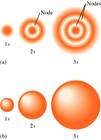
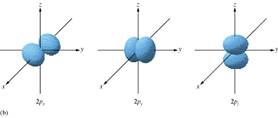
l |
Shape of Orbital |
|
|
|
|
|
|
|
|
|
|
|
|


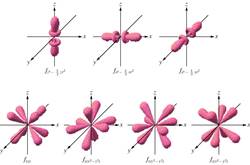 d-orbitals f-orbitals
d-orbitals f-orbitals
*Superimposed
Orbitals à
3. Third Quantum Number, ml (Magnetic Quantum Number)
- identifies the direction of orientation of the orbital with respect to external magnetic fields
Value of l |
Values of ml |
Total Number of Orientations |
|
|
|
|
|
|
|
|
|
|
|
|
|
|
|
4. Fourth Quantum Number, ms (Electron Spin Quantum Number)
- An electron can spin clockwise or counterclockwise.
- Spin can be indicated either through the use of +1/2 or -1/2
Summary of Quantum Numbers:
n |
l |
Orbital Notation |
ml |
Number of Orbitals in Subshell |
Total Number of Orbitals |
Total Number of Electrons In Shell (2n2) |
|
|
|
|
|
|
|
|
||||||
|
|
|
|
|
|
|
|
|
|
|
|||
|
||||||
|
|
|
|
|
|
|
|
|
|
|
|||
|
|
|
|
|||
|
||||||
|
|
|
|
|
|
|
|
|
|
|
|||
|
|
|
|
|||
|
|
|
|
|||
*A “2s” orbital is larger than a “1s” orbital, but they have the same shape (spherical).
*A “2p” orbital is made up of 3 “figure 8” shaped orbitals on a 3 axis system: px, py, and pz. All have the _________ shape, size and energy, but each points in a different direction depending on the axis it is situated on; that is, they all have a different _____________ in space around the nucleus of the atom.
ATOMIC STRUCTURE AND THE PERIODIC TABLE
*Energy Level Diagrams/Electron Configurations
Examples: a) Draw the energy level diagram for CALCIUM.
b) Write the electron configuration for CALCIUM.
*Remembering the Electron Order of Filling.
Method 1: Using a Diagonal Orbital Diagram
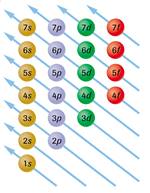
ß The diagram should be read as follows:
à 1s < 2s < 2p < 3s <
Method 2: Using the Periodic Table
*Examine the following periodic table. How can the periodic table be used to determine the electron order of filling?
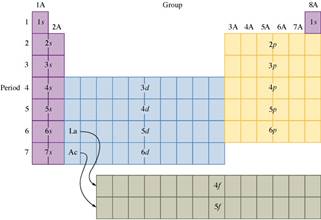
s-block elements à Groups à ____ and _____ (i.e. the alkali metals and alkaline earth metals)
d- block elements à Groups à____ to _____ (i.e. the transition metals)
p-block elements à Groups à ____ to _____
f-block elements à Groups à _______________ and ________________(i.e. the inner-transition metals)
Principles and Rule
1. Principle: Place electrons in the __________ energy orbital available until all electrons are “used up”. (“aufbau” is German for building up)
2. Principle: No two electrons can have the ________ four quantum numbers. Therefore, electrons in the same orbital must have opposite spins. (+1/2 or –1/2)
3. Rule: Electrons in the same orbital sublevel will not pair up until all magnetic orbitals of that orbital are at least _________ filled (i.e. have at least one electron in them)
Writing Electron Configurations of Ions
A. For ANIONS, ________ the appropriate # of electrons and account for these electrons when writing the electron configuration.
e.g. Write the electron configuration for:
i) fluoride (9 + _____) à
ii) sulfide (16 + _____) à
B. For CATIONS, ____________ from the orbital with the _____________ principle quantum number.
e.g. Write the electron configuration for:
i) neutral iron, Fe à
ii) Fe2+ à
iii) Fe3+ à
Writing Shorthand Electron Configuration Using the Periodic Table Method
Step 1 à Write the symbol for the ______________ noble gas in square brackets.
Step 2 à Add unaccounted for orbitals/electrons.
e.g. Write the shorthand electron configuration for:
i) Magnesium iii) Iodine
à à
ii) Chlorine iv) Bismuth
à à
Orbital Diagrams:
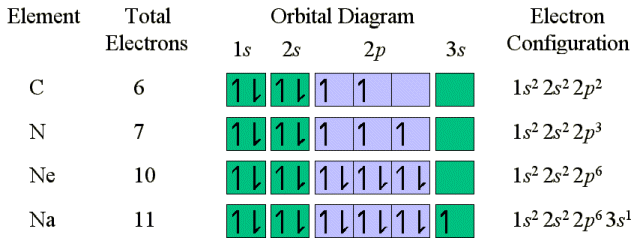
Anomalous (i.e. irregular) Electron Configurations
e.g. Draw the expected and actual electron configurations for i) copper, ii) silver, and iii) chromium using valence shell orbital diagrams.
![]() Wave/Quantum Mechanics, Orbitals and Electron Probability Density
Wave/Quantum Mechanics, Orbitals and Electron Probability Density
Review
à de Broglie hypothesized that an electron could behave like a _______(1923)
à de Broglie hypothesis received experimental support in 1927
àShrodinger, inspired by de Broglie’s idea of __________ _________, Einstein’s idea of ________energy particles (_________), and *Heisenberg’s proposed uncertainty principle, Schrodinger developed a branch of physics called wave mechanics, often referred to as ______________ mechanics.
à Quantum mechanics is the current theory of atomic structure. This model describes atoms as having certain allowed quantities of energy because of the wave-like properties of their electrons.
à Recall: Shrodinger used wave equations to predict the probability of finding an electron at a particular point in an atom. These wave equations are called orbitals.
 *Heisenberg Uncertainty Principle (1927) à Using mathematics, Heisenberg showed that it is _________ to show exactly where an electron is or how fast it is traveling.
*Heisenberg Uncertainty Principle (1927) à Using mathematics, Heisenberg showed that it is _________ to show exactly where an electron is or how fast it is traveling.
*Electron Probability Density à a mathematical or graphical representation of the chance of finding an electron in a given space (see pp. 200-201)
Extension à The Wave Nature of Matter (Website)
http://www.colorado.edu/physics/2000/quantumzone/debroglie.html:
*Sometimes light displays particle-like behavior, and sometimes it acts like a wave; it all depends on what sort of experiment you're doing. This is known as wave/particle duality, and, like it or not, physicists have just been forced to accept it.
 *If we begin to think of electrons as waves, we'll have to change our whole concept of what an "orbit" is. Instead of having a little particle whizzing around the nucleus in a circular path, we'd have a wave sort of strung out around the whole circle. Now, the only way such a wave could exist is if a whole number of its wavelengths fit exactly around the circle. If the circumference is exactly as long as two wavelengths, say, or three or four or five, that's great, but two and a half won't cut it.
*If we begin to think of electrons as waves, we'll have to change our whole concept of what an "orbit" is. Instead of having a little particle whizzing around the nucleus in a circular path, we'd have a wave sort of strung out around the whole circle. Now, the only way such a wave could exist is if a whole number of its wavelengths fit exactly around the circle. If the circumference is exactly as long as two wavelengths, say, or three or four or five, that's great, but two and a half won't cut it.
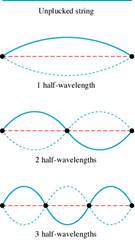 *So there could only be orbits of certain sizes, depending on the electrons' wavelengths --which depend on their momentum.
*So there could only be orbits of certain sizes, depending on the electrons' wavelengths --which depend on their momentum.
*If electrons are waves, then it makes sense that they don't give off or absorb photons unless they change energy levels. If it stays in the same energy level, the wave isn't really orbiting or "vibrating" the way an electron does in Rutherford's model, so there's no reason for it to emit any radiation. And if it drops to a lower energy level,, the wavelength would be longer, which means the frequency would decrease, so the electron would have less energy. (*E=hf) Then it makes sense that the extra energy would have to go someplace, so it would escape as a photon--and the opposite would happen if a photon came in with the right amount of energy to bump the electron up to a higher level.
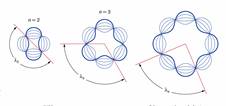
Source: http://www.dpcdsb.org/NR/rdonlyres/F6B16BEA-D25F-474C-9DC2-6C4A505CD0FE/63140/SCH4U1Unit1StructureandProperties200911.doc
Web site to visit: http://www.dpcdsb.org/
Author of the text: not indicated on the source document of the above text
If you are the author of the text above and you not agree to share your knowledge for teaching, research, scholarship (for fair use as indicated in the United States copyrigh low) please send us an e-mail and we will remove your text quickly. Fair use is a limitation and exception to the exclusive right granted by copyright law to the author of a creative work. In United States copyright law, fair use is a doctrine that permits limited use of copyrighted material without acquiring permission from the rights holders. Examples of fair use include commentary, search engines, criticism, news reporting, research, teaching, library archiving and scholarship. It provides for the legal, unlicensed citation or incorporation of copyrighted material in another author's work under a four-factor balancing test. (source: http://en.wikipedia.org/wiki/Fair_use)
The information of medicine and health contained in the site are of a general nature and purpose which is purely informative and for this reason may not replace in any case, the council of a doctor or a qualified entity legally to the profession.
The following texts are the property of their respective authors and we thank them for giving us the opportunity to share for free to students, teachers and users of the Web their texts will used only for illustrative educational and scientific purposes only.
All the information in our site are given for nonprofit educational purposes
The information of medicine and health contained in the site are of a general nature and purpose which is purely informative and for this reason may not replace in any case, the council of a doctor or a qualified entity legally to the profession.
www.riassuntini.com